Who Walks the Divorced Mother of the Bride Down the Aisle? Ceremony Etiquette Explained
In the nuanced choreography of a wedding ceremony, the moment when the mother of the bride walks down the aisle holds particular significance. When the mother is divorced, the decision of who should accompany her can become a point of consideration and, potentially, creativity. Tradition often sees the mother escorted by a male relative or groomsman, symbolically honoring her before she takes her seat. Yet, as customs evolve, the choice of escort for the mother of the bride widens to include a broader array of possibilities, reflecting the unique dynamics and preferences of each family.
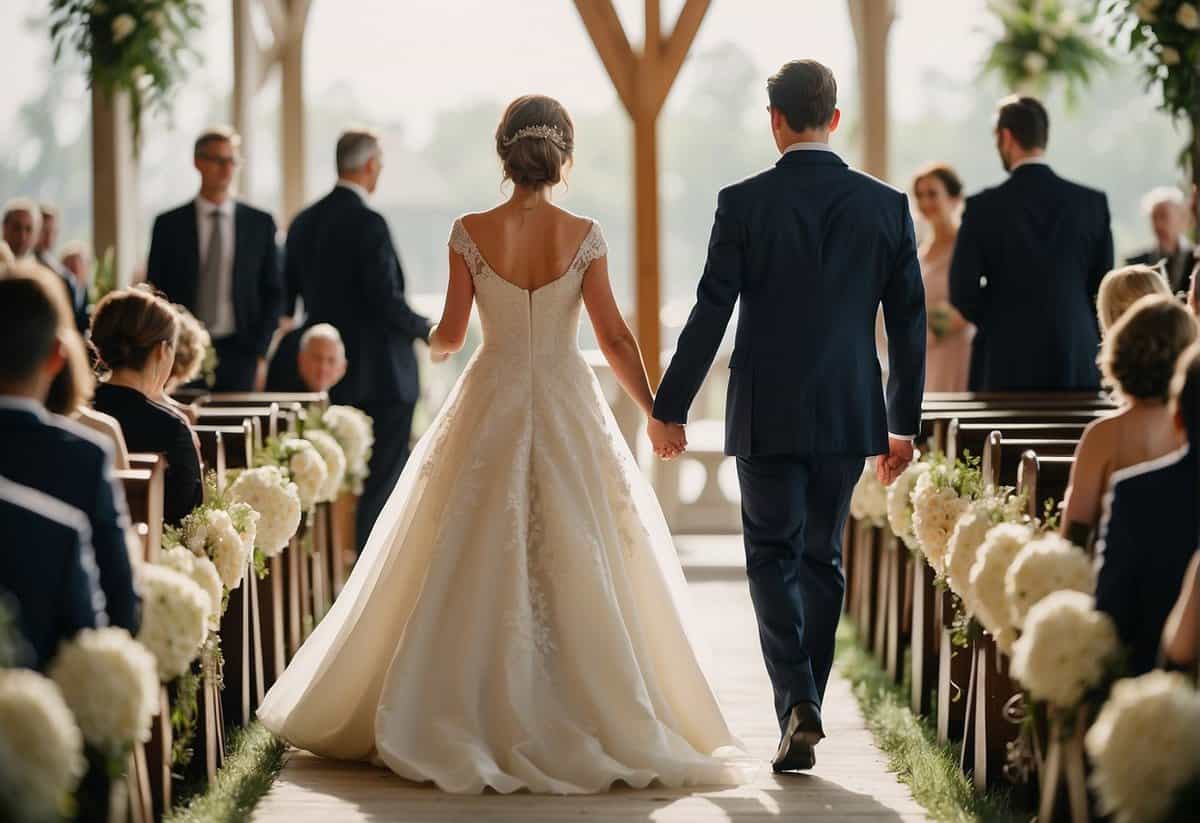
Selecting the right individual to walk alongside the mother of the bride is both a matter of protocol and personal sentiment. It’s an opportunity to acknowledge her role and contribution to the bride’s life. Whether choosing a son, a close relative, a stepfather, or even having her proceed alone, the focus is on ensuring the moment feels right for those involved. This aspect of the ceremony allows for a blend of respect for tradition with a celebration of the family’s individual story, making the procession an inclusive and heartfelt experience.
Key Takeaways
- The escort for the mother of the bride at a wedding can be a traditional choice or a more personal one.
- The decision should reflect the mother’s importance and the family dynamics.
- Modern weddings allow flexibility in ceremonial roles to honor the bride’s mother.
Understanding The Role Of The Mother Of The Bride
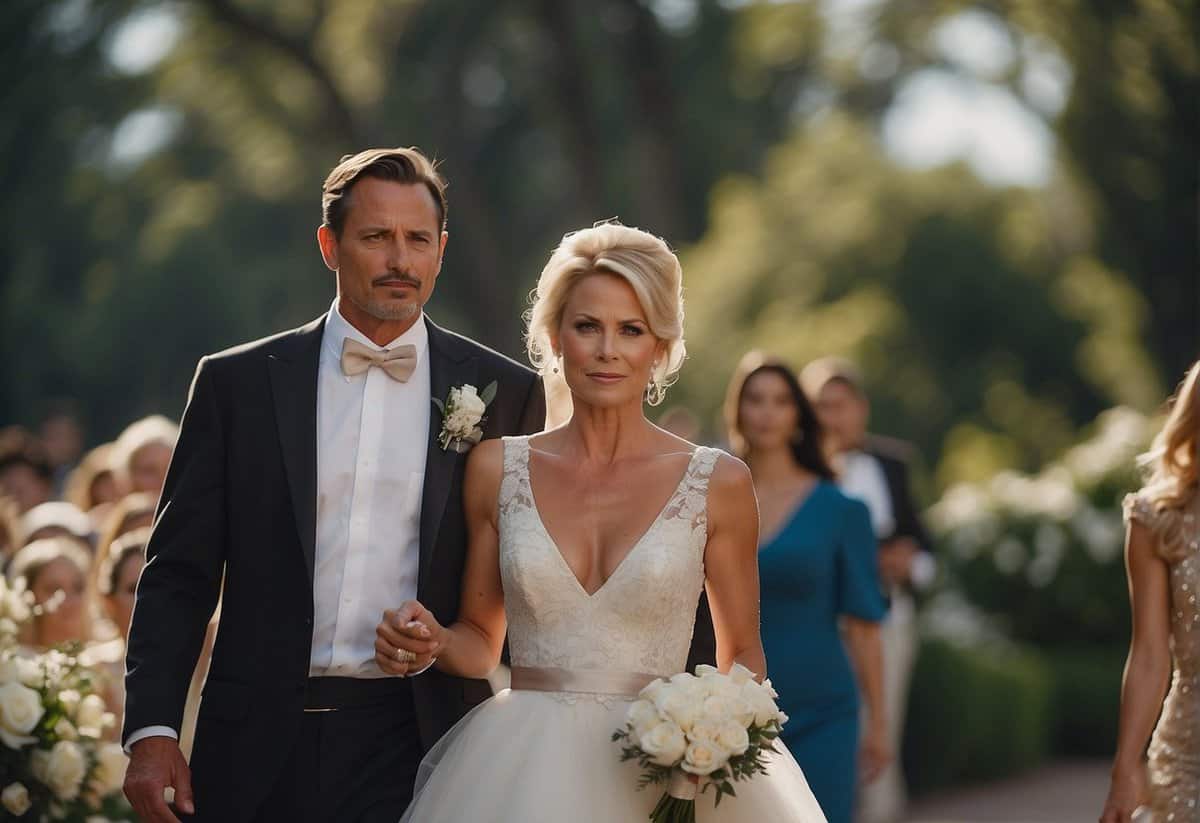
As the mother of the bride, your role is steeped in tradition and emotion. It’s a position that symbolizes love, support, and the enduring strength of family relationships. You’re the matriarchal figure who has witnessed your daughter grow and blossom; now, you’re witnessing her step into a new chapter of her life.
Emotional Support: Your presence offers immense comfort to your daughter during the stressful wedding planning phase. You’re her confidante, cheerleader, and advisor, all wrapped in one.
Family Dynamics: Navigating the intricate dynamics of a modern family, especially if you’re divorced, requires grace and understanding. Your role may involve coordinating with the father of the bride and other family members to maintain harmony.
Tradition and Transition: Historically, you would be the last to be seated before the ceremony begins, signaling your critical role. In a situation where parents are divorced, you may be escorted down the aisle accompanied by a groomsman, another family member, or walk solo, underscoring your dignity and pride in your daughter.
Your walk down the aisle is a touching moment, a public acknowledgment of the pivotal part you play in your daughter’s life. It’s a reflection of the unwavering support you have provided and will continue to offer as she steps into marriage. Whether you’re escorted or you walk alone, this journey is more than mere tradition; it’s a statement of the boundless love and support that encircles your daughter’s big day.
Selecting The Right Escort For The Processional
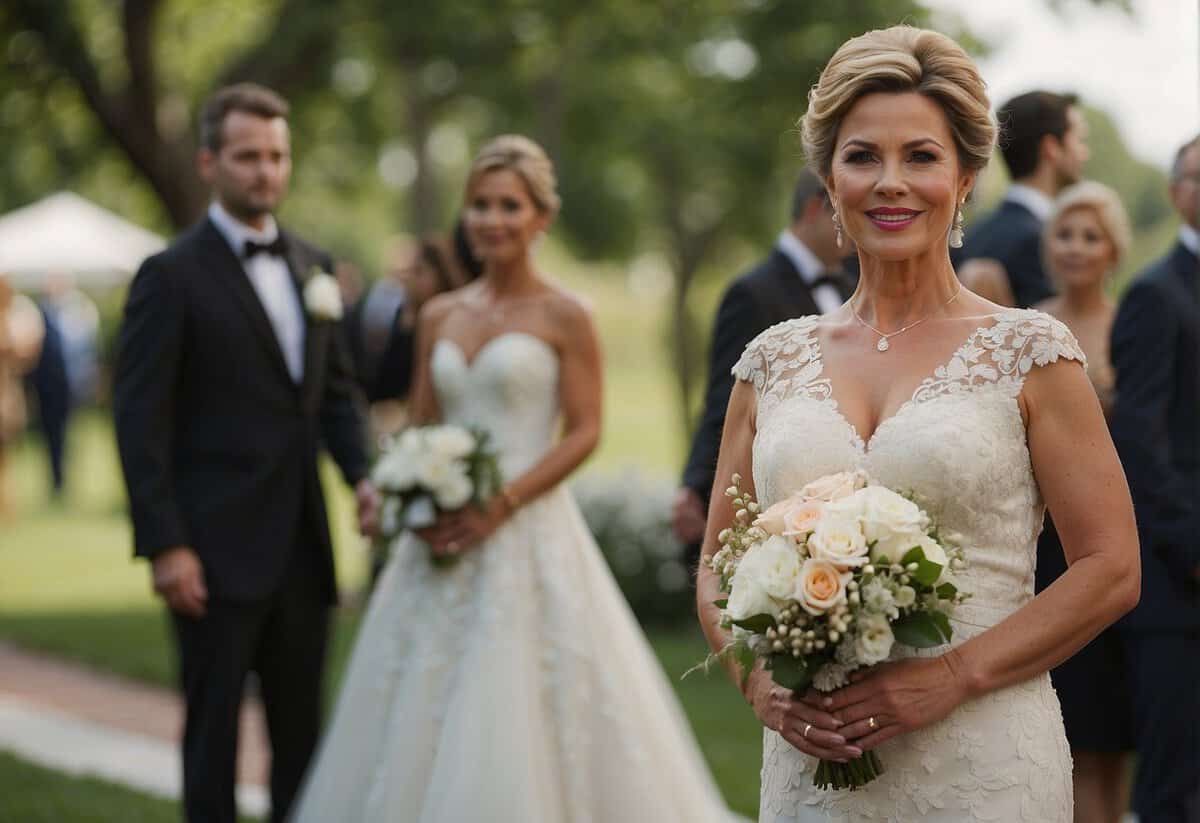
When you’re planning the processional for your wedding, and especially when determining who should accompany your divorced mother down the aisle, you’ll want to consider a few key points. Your mother’s comfort and the dynamics of your family relationships are paramount.
Consider Close Family Members
- Son: If you have a brother, he might be the perfect choice to escort your mother, providing a touching moment.
- Male relative: A close male relative, such as an uncle or cousin, can also fill this role with respect and dignity.
Including Stepfamily
- If your mother has remarried, your stepfather could be a great option to consider for the role.
- In some cases, it’s possible to have both parents walk her down the aisle if the relationships involved are amicable.
Your Wedding, Your Rules
Remember, traditional roles can be adapted. Here are some options you might like:
- Father: Despite divorce, some families opt for the father to escort the mother, emphasizing unity for the occasion.
- Alone: Your mother might prefer to walk down the aisle by herself, proudly taking her place of honor.
Processional Etiquette
The wedding processional is a key part of the ceremony. It’s the grand entrance, so to speak, and these guides put the focus on pacing and order—two elements that ensure a graceful flow. Let’s quickly look at some details:
- Pacing: There should be an approximate four paces between individuals walking down the aisle.
- Order: The mother of the bride typically takes her seat immediately before the bridal party enters.
In summary, talk with your mother about her preference, consider your family situation openly, and choose an escort that will make this moment feel special and celebratory.
Ceremonial Variations And Traditions
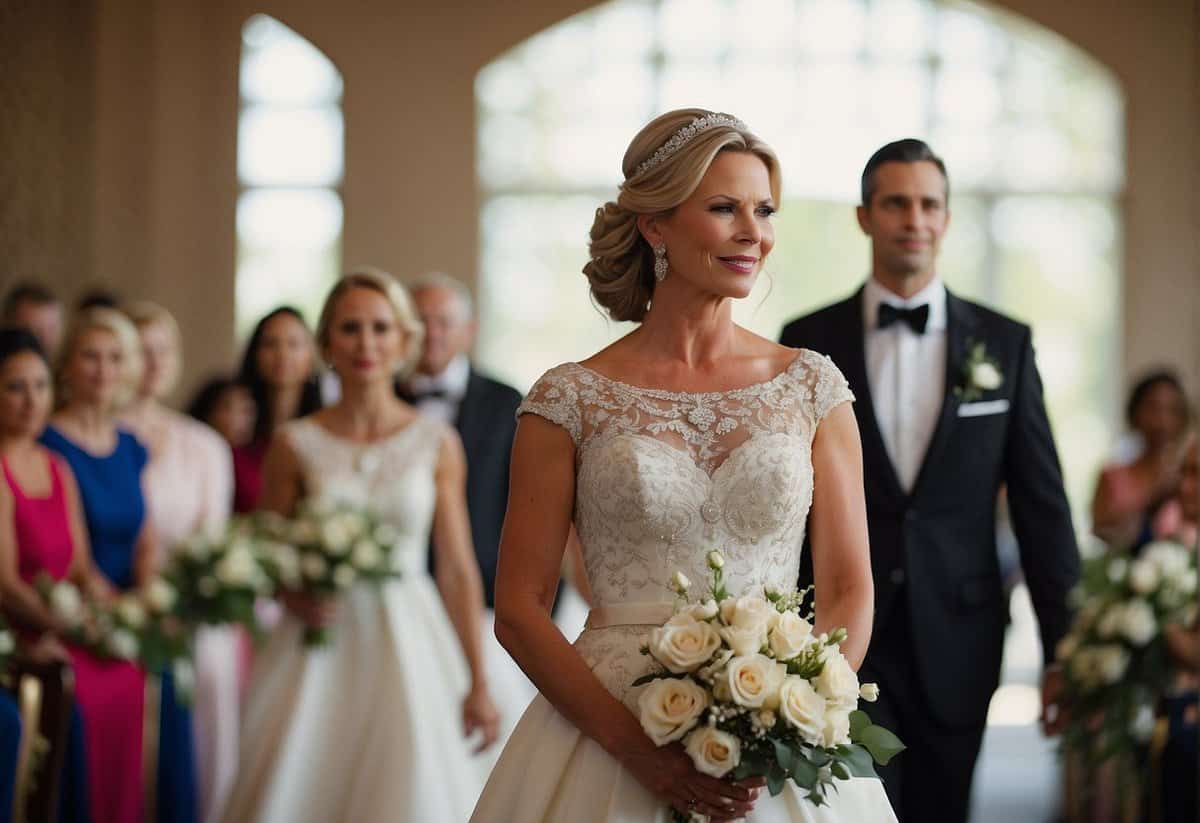
When you plan a wedding ceremony, understanding the variety of traditions that dictate who walks the mother of the bride down the aisle can feel both meaningful and overwhelming. Whether your heritage is steeped in deep cultural customs or you opt for a contemporary, nondenominational approach, each tradition offers its unique take on this special moment.
Traditional Christian Ceremonies
In Traditional Christian Ceremonies, the processional order typically includes the groomsmen and bridesmaids, followed by the groom, and then the bride. The mother of the bride is usually escorted down the aisle by an usher or a close male relative before the bridal party makes their entrance. This act is both a symbol of honor for the mother and signifies her role in the ceremony.
Jewish Wedding Practices
During Jewish Wedding Practices, the processional is distinct and inclusive of family members. Jewish ceremonies often involve both parents walking the bride and groom down the aisle, reflecting the unity of families. If the mother of the bride is divorced, she might walk alone, or if amicable, alongside her ex-spouse, symbolizing continuity and respect for family.
Hindu Processional Customs
In Hindu Processional Customs, the wedding procession (Baraat) is vibrant and led by the groom, who traditionally arrives in a procession with music and dancing. The bride’s mother’s role can vary, but she is often involved in significant rituals before the wedding (such as the Kanya Daan, where the bride is ‘given away’). Usually, an elder male relative or the bride’s brother might accompany the divorced mother of the bride in the processional.
Modern And Nondenominational Adaptations
Modern And Nondenominational Adaptations to weddings allow more flexibility, and thus you can personalize the processional to suit your family’s circumstances and preferences. While there’s no strict order, it’s common for the mother of the bride to be escorted by a family member or even walk down the aisle alone if she prefers, symbolizing her strength and independent role in her daughter’s life. In many nondenominational weddings, the key is to create a moment that feels right for you and your family.
Coordinating The Wedding Party

When organizing your wedding party’s entrance, there’s a traditional order for the procession, but always remember you have the freedom to choose an order that best suits your family dynamics.
Walking Down the Aisle:
The processional begins with the groomsmen, who may walk down in pairs or individually. Following them, your best man takes his place, generally standing by the groom. It’s now time for your bridesmaids to make their way down the aisle, perhaps paired with groomsmen if they walked down individually. The maid of honor goes after, paving the way for the stars of the show.
Special Roles:
The flower girl and ring bearer add that adorable factor, typically walking down together right before the main event.
| Order | Participants |
|---|---|
| 1st | Groomsmen |
| 2nd | Best Man |
| 3rd | Bridesmaids |
| 4th | Maid of Honor |
| 5th | Flower Girl & Ring Bearer |
For divorced parents, your divorced mother can be escorted by a relative or a groomsman as suggested by The Knot. And if you have a stepmother, she is seated beforehand.
Remember, it’s your special day, and while tradition can guide you, it’s about what makes you comfortable and honors your loved ones.
Frequently Asked Questions
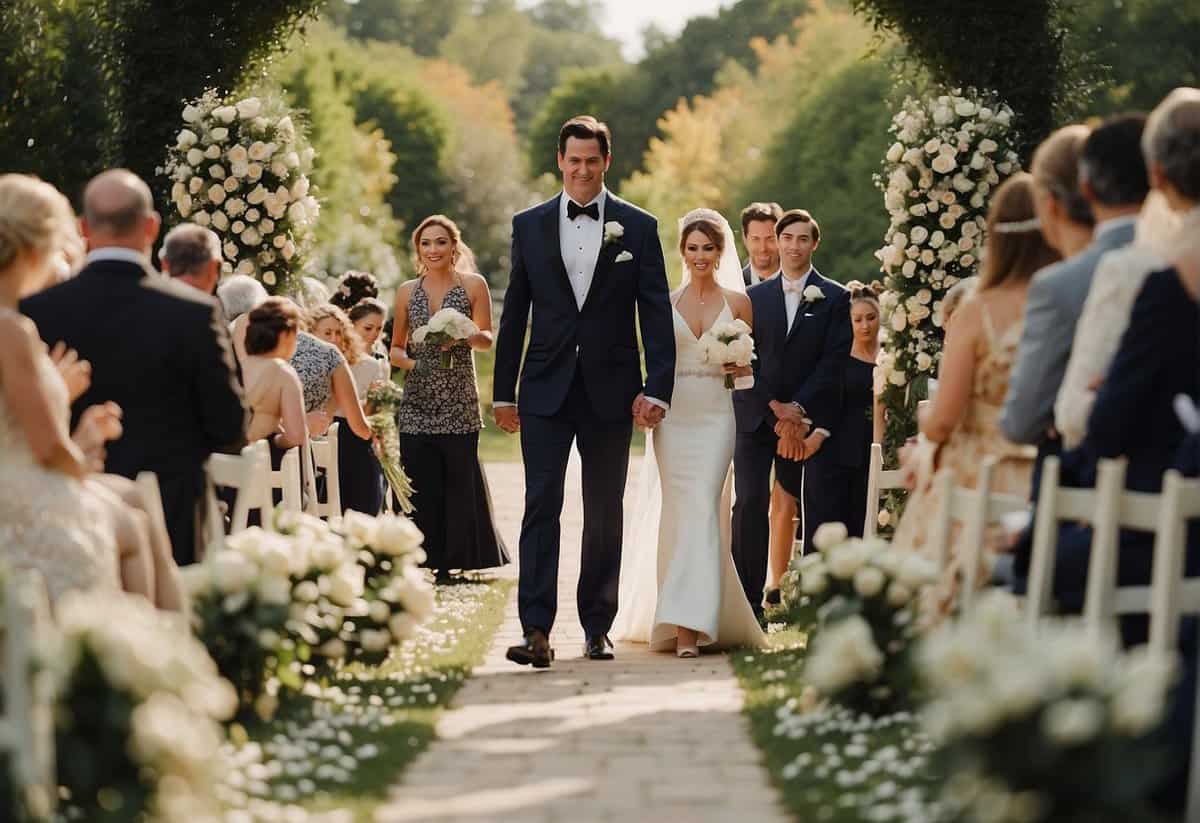
When it comes to your role in a wedding as the mother of the bride, knowing the proper etiquette can help ensure the day goes smoothly. These FAQs will give you the guidance necessary for a seamless and respectful ceremony.
What is the etiquette for the mother of the bride’s procession in a Catholic wedding?
In a Catholic wedding, it’s traditional for the mother of the bride to be the last to be seated before the bridal processional begins. She is often escorted by a family member or a groomsman.
How should divorced parents who do not get along be seated at their daughter’s wedding?
Divorced parents who are not on good terms should be seated separately to avoid any discomfort. The mother of the bride should be seated first, in a place of honor, and the father can be seated elsewhere yet in a respectful position.
What song is appropriate for the mother of the bride to walk down the aisle to?
Choose a song for the mother of the bride’s entrance that has sentimental value or conveys respect. Instrumental music or a soft ballad are commonly chosen for this moment.
What are the guidelines for including grandmothers in the wedding procession?
Grandmothers are typically escorted down the aisle after the mothers of the bride and groom and before the bridal party. They can be accompanied by a family member or an usher.
In which order should the mothers be walked down the aisle during the ceremony?
Traditionally, the groom’s mother is seated first, followed by the bride’s mother, who is the last to be seated before the bridal processional starts. It’s a sign of honor for the mother of the bride.
How can divorced parents best be included in the wedding while maintaining proper etiquette?
Even in the case of divorce, parents can be included in the ceremony in a tactful way. Ensure each parent feels valued by assigning them roles that reflect their relationship with the bride, such as readings or special seating, while keeping the peace on this important day.
